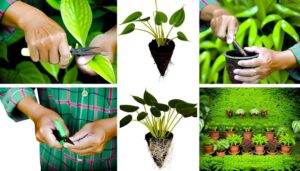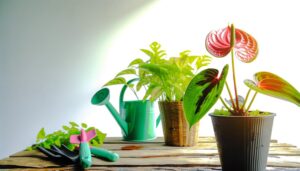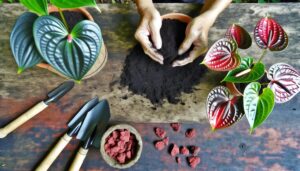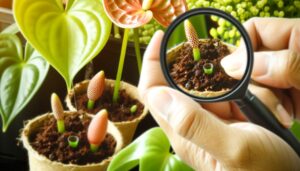7 Essential Tips for Anthurium Gracile Care
Optimize the flourishing of your Anthurium Gracile by providing bright, indirect light and maintaining temperatures between 65-80°F. Keep the soil consistently moist but avoid overwatering; water when the top inch dries out.
Enhance humidity using a hygrometer, aiming for 60-80%. Employ a well-draining potting mix with orchid bark and perlite, checking soil pH regularly.
Fertilize bi-weekly with a diluted 20-20-20 N-P-K solution during growing seasons. Inspect for pests routinely and use neem oil or insecticidal soap as needed.
These meticulous care steps will help your Anthurium thrive, but there’s more to mastering its care.

Key Takeaways
- Place Anthurium Gracile in bright, indirect light to mimic its natural habitat.
- Keep soil consistently moist but avoid waterlogging by watering when the top inch is dry.
- Maintain high humidity levels (60-80%) using a humidifier or placing in moisture-rich areas.
- Use a well-draining potting mix with materials like orchid bark and perlite to prevent root rot.
- Fertilize bi-weekly with a diluted balanced fertilizer (20-20-20 N-P-K) during the growing season, reducing frequency in winter.
Optimal Light Conditions

Anthurium Gracile thrives best when it receives bright, indirect light, which mimics its natural understory habitat.
You’ll want to position your plant near a window with filtered sunlight or use a sheer curtain to diffuse direct rays.
This species relies on photosynthetically active radiation (PAR) within the range of 400-700 nanometers for peak chlorophyll synthesis. Avoid placing it in dim-light conditions, which can hinder growth and reduce leaf vibrancy.
Conversely, excessive direct sunlight can cause photoinhibition, leading to leaf burn and cellular damage.
Regularly rotate the plant to ensure uniform light exposure. By providing optimal light conditions, you support the plant’s physiological processes, enhancing its aesthetic appeal and ensuring its long-term well-being for those you care for.
Ideal Temperature Range
You’ll need to maintain Anthurium Gracile within a prime temperature range of 65-80°F (18-27°C) for robust growth. This species tolerates minor fluctuations but is sensitive to extreme changes.
During colder months, make sure temperatures don’t drop below 60°F (15.5°C) to prevent stress and potential damage.
Optimal Temperature Range
Maintaining a consistent temperature range between 65°F and 75°F is essential for ideal Anthurium Gracile growth.
To achieve this, you should monitor indoor environmental conditions carefully, utilizing a reliable digital thermometer.
The Anthurium Gracile, native to tropical rainforests, thrives in stable thermal environments. Avoid placing the plant near drafts, air conditioning vents, or heaters, as these can disrupt the delicate thermal balance.
Additionally, make sure that nighttime temperatures don’t drop significantly, as this species prefers minimal temperature variance.
By maintaining this ideal range, you’ll support robust photosynthesis, nutrient uptake, and overall plant health.
Your attention to these precise conditions will foster a flourishing Anthurium Gracile, rewarding your meticulous care with vibrant, healthy foliage.
Temperature Fluctuation Tolerance
Given the Anthurium Gracile‘s sensitivity to environmental changes, it’s important to minimize temperature fluctuations to achieve ideal growth and health. Aim to maintain a consistent temperature range between 65°F and 80°F (18°C to 27°C).
Sudden drops below 60°F (15°C) or spikes above 85°F (29°C) can stress the plant, leading to stunted growth or leaf damage. Use a reliable thermometer to monitor ambient conditions closely.
If possible, avoid placing the plant near drafty windows, heating vents, or air conditioning units, as these can cause unwanted temperature variations.
Incorporating a stable microenvironment, such as a terrarium or controlled indoor garden, can further enhance the Anthurium Gracile’s resilience to minor temperature shifts, ensuring optimal care and vitality.
Seasonal Temperature Adjustments
To achieve peak growth, adjust the Anthurium Gracile’s temperature settings seasonally, aiming for the lower end of its ideal range during winter and the higher end during summer.
Maintain winter temperatures between 60-65°F (15-18°C). This range minimizes metabolic stress and conserves energy.
In summer, regulate the environment to 70-80°F (21-27°C) to maximize photosynthetic efficiency and growth rates.
Avoid drastic fluctuations; rapid temperature changes can induce stress responses, leading to stunted growth or leaf drop. Utilize digital thermometers to monitor and control these parameters precisely.
Additionally, optimize humidity levels (60-80%) to complement temperature adjustments. By adhering to these guidelines, you’ll create an ideal microclimate, promoting robust health and vigorous development in your Anthurium Gracile.
Proper Watering Techniques
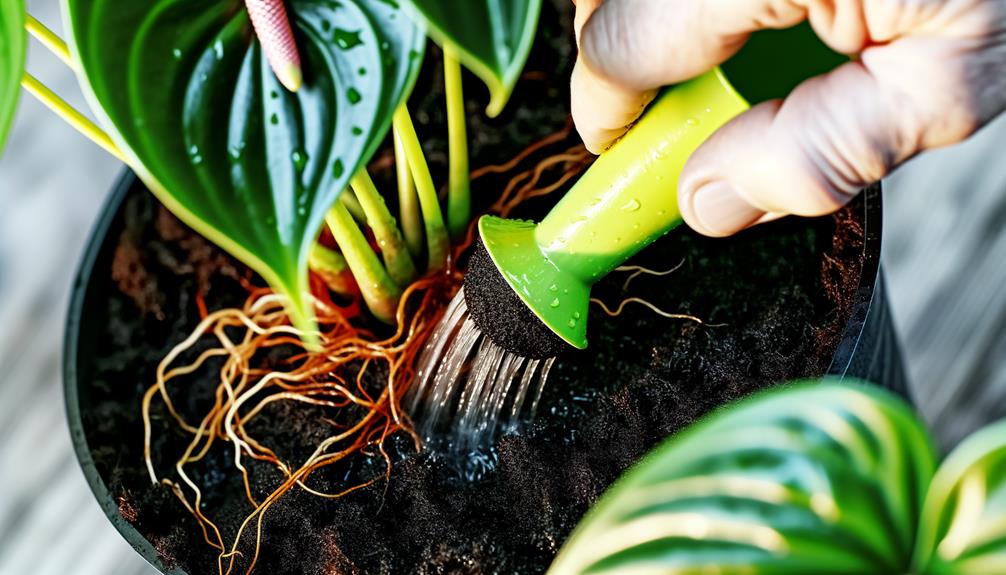
Watering your Anthurium Gracile correctly involves ensuring the soil remains consistently moist but not waterlogged.
This can be achieved by using a well-draining potting mix and watering thoroughly when the top inch of soil feels dry to the touch.
Utilize room-temperature, dechlorinated water to prevent stress on the plant. Pour water evenly around the base until it drains from the bottom of the pot, ensuring no standing water remains in the saucer.
Monitor humidity levels, aiming for 60-80%, as inadequate humidity can lead to desiccation. Implement a regular watering schedule, adjusting frequency based on seasonal changes and indoor climate conditions.
Consistent moisture management fosters optimal growth and health, enabling you to serve your Anthurium Gracile most effectively.
Soil and Potting Mix
To optimize Anthurium Gracile growth, you should use a well-draining potting mix that mimics its natural habitat. Combine ingredients like orchid bark, perlite, and peat moss to achieve the ideal soil composition.
Ensuring proper drainage prevents root rot and promotes healthy development.
Ideal Soil Composition
A well-draining, aerated soil mix rich in organic matter is crucial for the best growth of Anthurium Gracile. You should aim for a mixture that promotes root oxygenation and prevents waterlogging.
An ideal soil composition includes materials that improve drainage, such as perlite or pumice, balanced with moisture-retentive elements like peat moss.
Additionally, incorporate organic matter like compost to supply essential nutrients and support microbial activity.
Maintain the pH at a slightly acidic to neutral level, around 5.5 to 6.5. Regularly check the soil’s consistency and adjust as necessary to sustain prime conditions.
Potting Mix Ingredients
Selecting the right potting mix ingredients is key to ensuring ideal drainage and root health for your Anthurium Gracile. You’ll need a blend that mimics its natural epiphytic environment.
Start with a base of orchid bark for aeration, then add sphagnum moss to retain moisture without waterlogging.
Incorporate perlite to improve drainage and prevent soil compaction. A small amount of activated charcoal helps keep the mix fresh by absorbing impurities.
Finally, add a bit of coconut coir for its water retention properties and slight acidity. This combination guarantees optimal moisture levels, aeration, and nutrient availability.
Always aim for a light, airy mix that balances moisture retention and drainage, essential for the plant’s health and longevity.
Drainage Considerations
Ensuring proper flow for your Anthurium Gracile involves using a well-structured potting mix that prevents water from stagnating. Aim for a mix comprising equal parts orchid bark, perlite, and peat moss.
This combination offers excellent aeration and moisture retention while allowing excess water to escape.
The orchid bark provides structural integrity, perlite enhances flow, and peat moss maintains consistent hydration levels.
Additionally, make sure your pot has drainage holes to facilitate water flow. Regularly check the soil moisture, allowing the top inch to dry out between waterings. This practice prevents root rot and promotes healthy growth.
By meticulously managing flow, you’ll create an optimal environment for your Anthurium Gracile, ensuring it thrives and enhances your space beautifully.
Fertilizing Schedule

Consistently fertilizing your Anthurium Gracile promotes excellent growth and vibrant foliage. Use a balanced, water-soluble fertilizer with an N-P-K ratio of 20-20-20.
Apply it bi-weekly during the growing season, typically from spring through early autumn. Dilute the fertilizer to half the recommended strength to prevent root burn.
Guarantee even distribution to avoid nutrient imbalances. During the dormant winter months, reduce fertilizing to once a month or cease altogether, as the plant’s metabolic rate slows down. Always water the plant before applying fertilizer to minimize the risk of root damage.
Regular soil testing will help you monitor nutrient levels and adjust your fertilizing schedule accordingly. This meticulous attention guarantees your Anthurium Gracile thrives, boasting lush and healthy foliage.
Humidity Requirements
Maintaining high moisture levels, ideally between 70-80%, is essential for the optimal growth of Anthurium Gracile.
This tropical plant thrives in environments that mimic its native habitat. You should monitor moisture using a hygrometer to ensure consistency.
Misting the foliage can provide a temporary moisture boost, but for sustained levels, consider using a humidifier. Preferably, place your Anthurium Gracile in a room with naturally high moisture, like a bathroom.
Alternatively, create a microenvironment by grouping plants together or employing a pebble tray filled with water beneath the pot.
Avoid placing it near vents or drafts as they can greatly reduce moisture levels. By prioritizing moisture, you’ll foster strong growth and vibrant foliage.
Pest and Disease Control
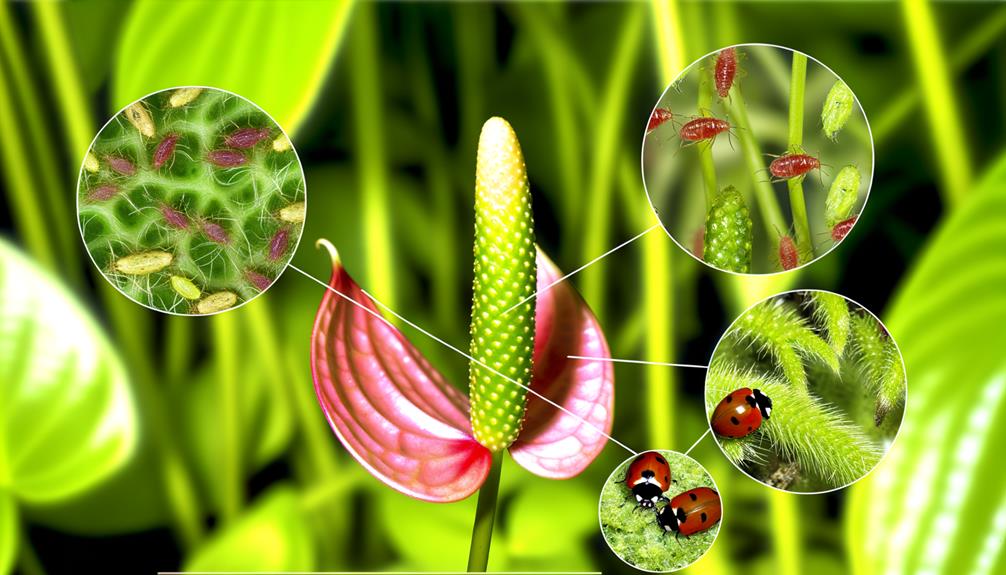
To effectively manage pest and disease control for Anthurium Gracile, regularly inspect the leaves for signs of common issues like spider mites, aphids, and fungal infections. Use a magnifying glass to detect tiny pests early.
Apply neem oil or insecticidal soap to remove spider mites and aphids. Maintain adequate ventilation to prevent fungal growth, and avoid overwatering, as moisture promotes fungal infections.
If you notice yellowing or spotted leaves, prune the affected areas and dispose of them properly. Sterilize your tools before and after use to prevent cross-contamination.
For severe infections, consider using systemic fungicides. Consistently monitoring and maintaining clean, dry conditions will notably reduce the risk of pests and diseases, ensuring your plant remains healthy.
Conclusion
In sum, mastering anthurium gracile care isn’t as intimidating as it seems. By ensuring ideal light, maintaining the right temperature, following precise watering techniques, using appropriate soil, sticking to a fertilizing schedule, and managing humidity, you’ll promote robust growth.
Here’s a theory: consistent care might even enhance the plant’s resilience to pests and diseases. Why not test it? Your meticulous attention could be the key to unleashing your anthurium’s full potential.

